Brahmin Event
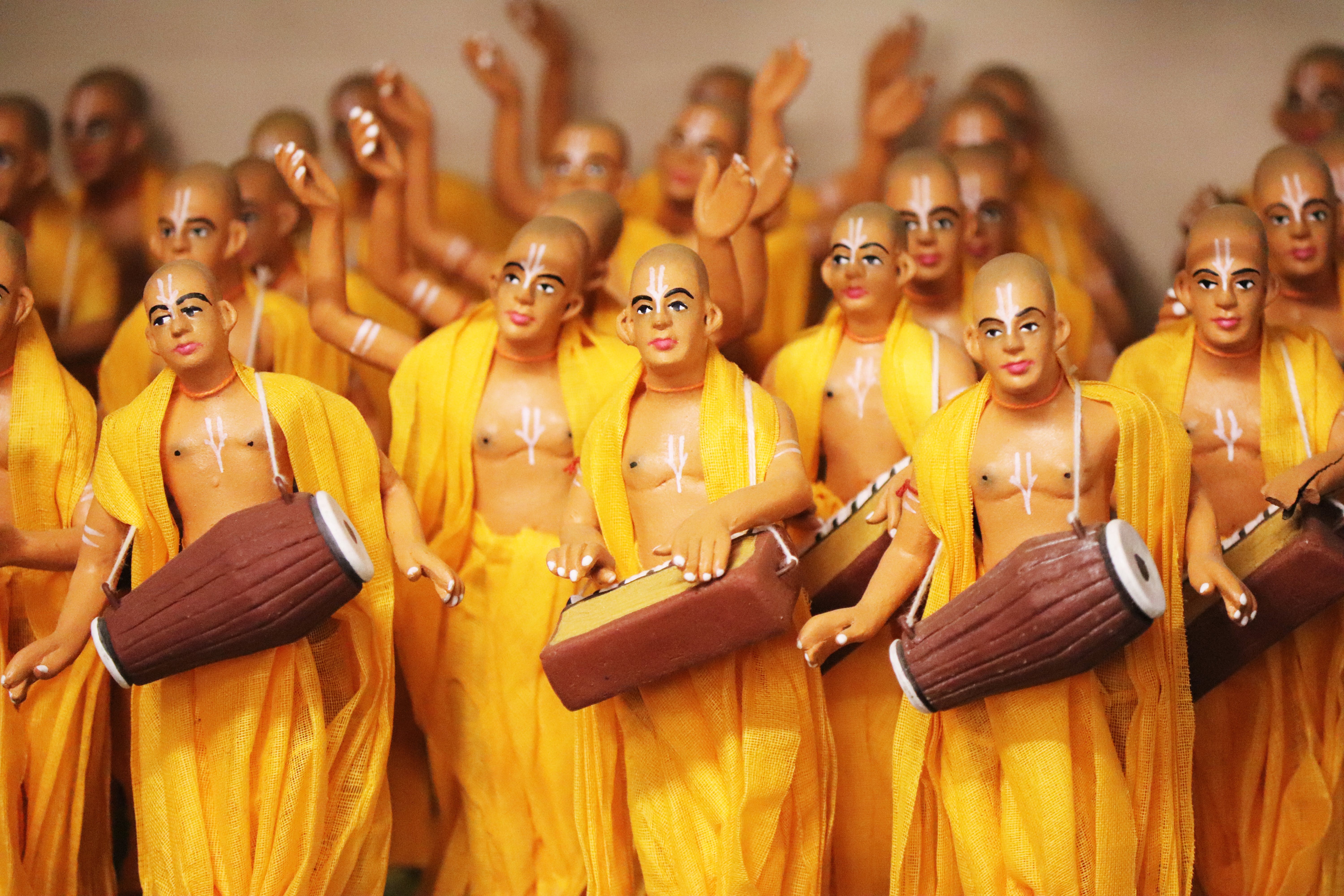
Brahmin Event Organiser
It is very Important to Have tradition, Dharmic As well As creative in Brahmin function where shastra, Mantra & rituals are very Important. Our rishi’s done great Upakar & help to Brahmin community & guided to conduct Ceramony start from Jaata karma, upanayana to Vivaha. Due to Lack of Time, Knowledge & non- availability of Proper Vedic Purohit functions are losing its importance & just getting get-together function.
Yatra 2 pooja makes sure to Have a function as per Dharmic text Vidhi with modern aesthetics where people will remember function for whole life.
Chandi/Sapta shati Paarayanam (Laxmi Narayana hrudaya, Sundara Kanda) To Homam including all Pooja Materials & food.
Currently we are serving Bangalore Brahmin Event organising. Shortly will be operating In Hyderabad & Chennai.
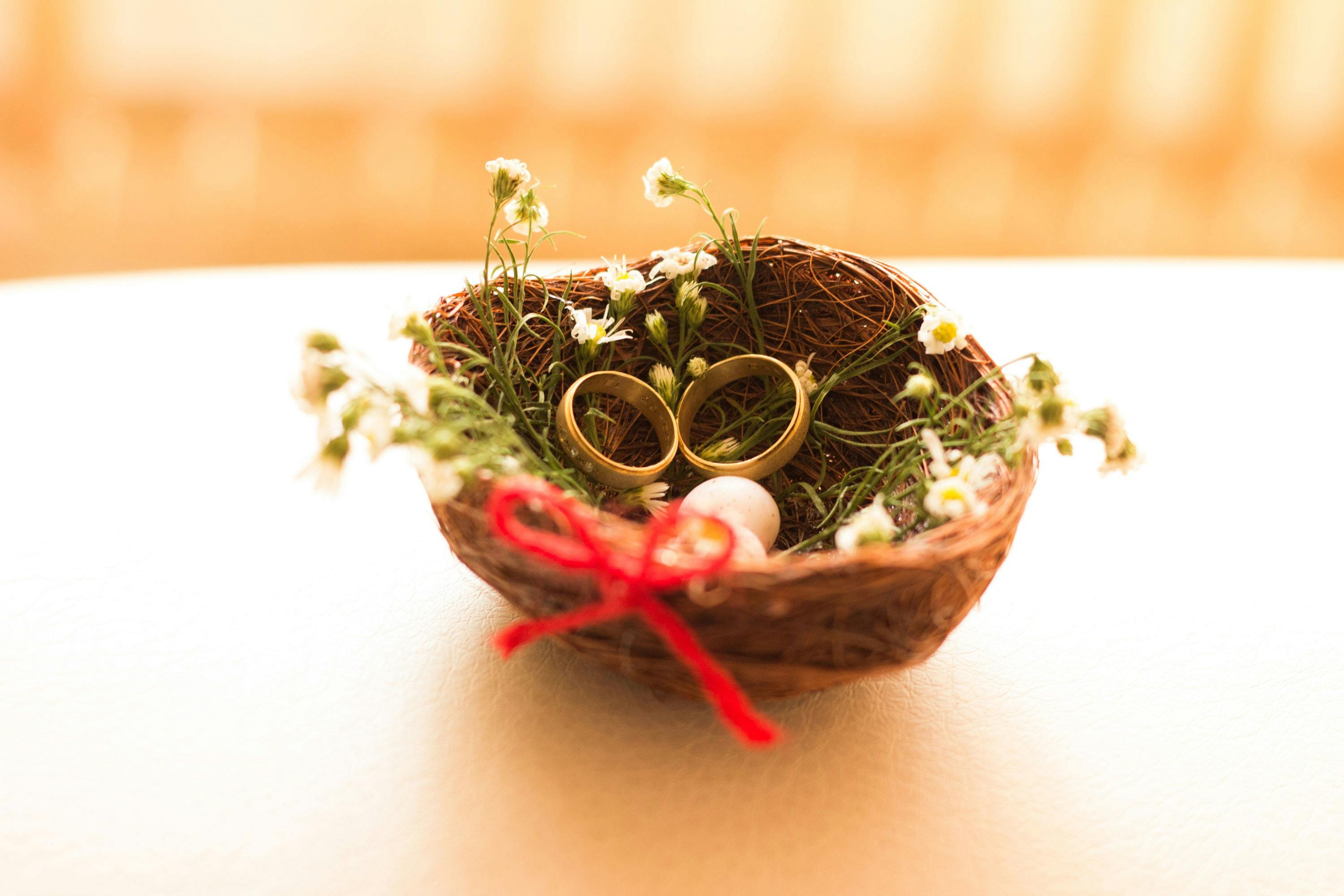
Engagement/ Lagna patrike / Nischaya
The engagement ceremony is one of the main High lights of the Indian wedding. It is fun filled event held at either the bride or groom place in the attendance of relatives & close friends from Both sides.
Families get prepared lagna Patrika (wedding letter) in presence of purohit & panchang, which is formal declaration & vagdaan (promise) to each other to perform wedding. Good tithi, Vaara, Nakshtra, Yoga, Karana, guru bala will be considered in preparation of Lagna patrika.
2 copies will be written, Pooja for lord Ganesh & patrika done from the Both Families. Exchange patrika with Phala conducted with vagdaan.
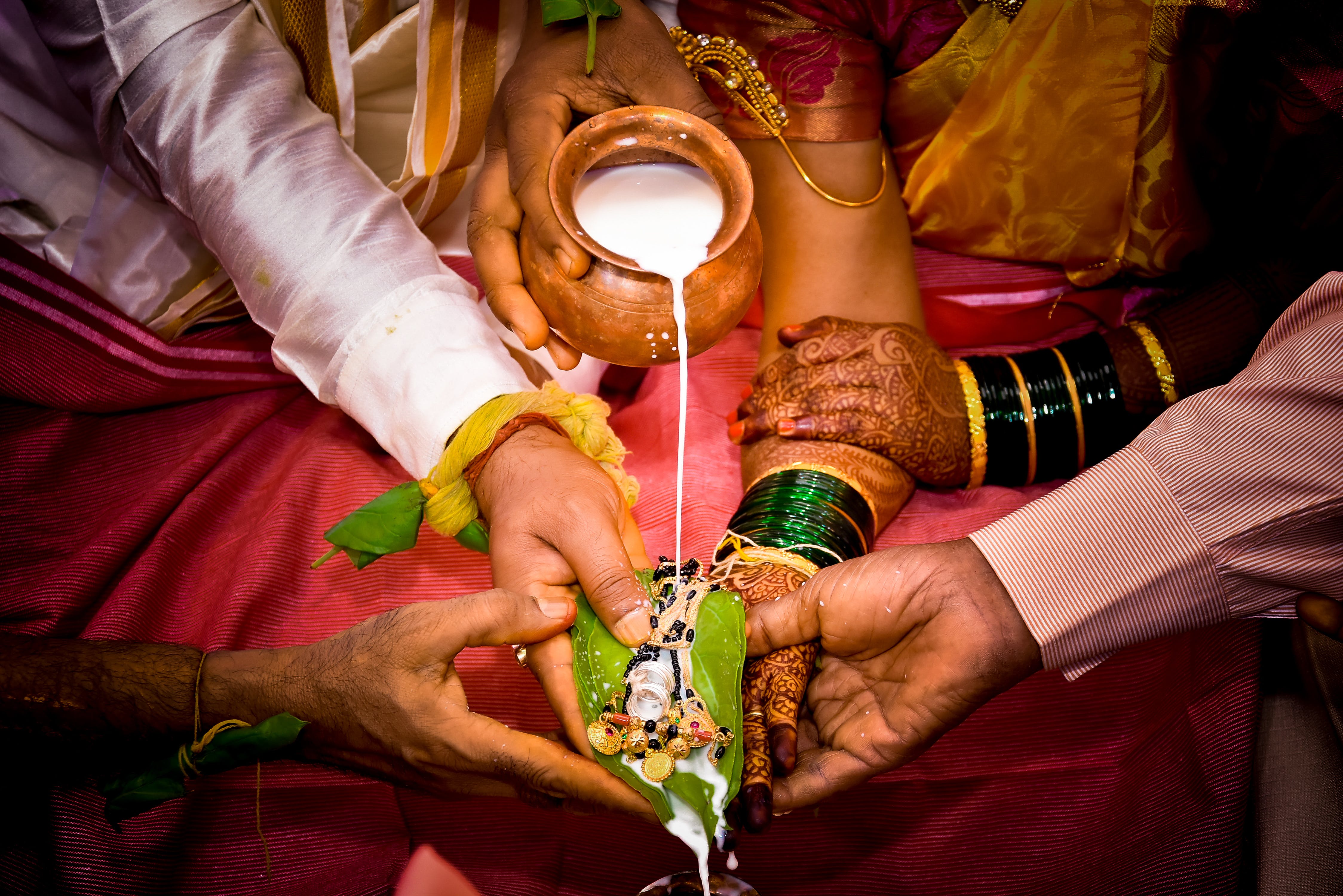
Wedding /Marriage ceremony/ Vivaha samskara
Hindu Dharma has prescribed four Purusharthas, that is Dharma (Righteousness), artha (Material gain), kama (Desire) and Moksha (Final Liberation). The purpose of the Vivaha Sanskar (Hindu wedding) is to ful?ll the Purushartha of ‘kama’ and then gradually advance towards ‘Moksha’.
Vivaha, which originally meant the wedding ceremony, but has to acquire the definition of marriage as a whole, is meant for procreation, and the establishment of a family (Kutumba). After one's wedding, one is believed to have entered the second stage of life, the grihastha ashrama, performing the duties of a household.
Marriage is considered to be necessary to fulfil these goals. The three goals of marriage include allowing a husband and a wife to fulfil their dharma, bearing progeny (praja), and experiencing pleasure (rati). Sexual intercourse between a husband and wife is regarded to be important in order to produce children, but is the least desirable purpose of marriage in traditional Hindu schools of thought.
Yatra 2 pooja organise brahmin Marriage as per Dharmic vidhi
- Devara samradhane
- Hooveelya
- Chappara pooje
- Samavarthane
- Vara pooje
- Gowri pooje
- Kaashi yatre
- Antarpata
- Kanya-daana
- Kankana bandhana
- Maangalya dharana
- Akshataaropana
- Paani-grahana
- LaaJa homa
- Sapta padi
- Arundati nakshatra Darshana
- Vadhu Gruva praseha

Upanayana / Bramhopadesha
The ceremony marks the second birth of the child in the world of knowledge. thus, onwards children are called 'dwij' meaning twice born. Sacred thread is cotton, handmade 3 strings tied in a loop. Worn on the left side shoulder it crosses body onto right side of the torso. Yajnopavita is a sacred thread. This will have three strands with a knot resembling a sitting cow. The three strands represent three Veda’s and the knot represents Atharva Veda.
It also represents the first three stages of life i.e., Brahmacharya, Gruhasta and Vanaprastha. upanayana is a Hindu rite of passage ritual primarily for boys, marking their rebirth into the world of the Vedas and their readiness to learn the tradition. In the middle of the ceremony, boys are given special tradition garments, often in the form of a new white silk dhoti. They are also given the “sacred thread” in the form of a cord tied over the left shoulder and under the right arm. These materials signify the boy’s readiness for learning, studying the Veda, and performing rituals.
- Punyaha
- Naandi
- Udaka shanti (for Yajur vedi’s)
- Ganapati – Navagraha homa
- Chooda karma
- Maatru saha bhojana
- Vastra – moungi- danda – peta dharana
- Antarpata /mangalshtaka
- Yajnopavita daana – dharana
- Anu -pravachana
- Paada pooje of Father/Guru
- Gayatri Upadesha
- Agni Karya
- Matru paada pooje
- Matru Bhiksha
- Sandhya Vandana
- Danda visarjan

Gruha Pravesha – Vaastu Shanti
Gruha Pravesh is a minor form of space consecration. No one would ever live in a house that had not been consecrated. All of this was done primarily to instil a greater sense of life energy in the people who lived in this house so that they would naturally gravitate towards happiness.
Gruha Pravesh is a deeply rooted tradition aimed at seeking the blessings and protection of the deities for the new home and its occupants. It is believed that performing this ritual on an auspicious day and time attracts positive energy, happiness and abundance to the household.
Before entering the new home, Gruha Pravesh involves performing various rituals and ceremonies to purify the living space. These rituals include Vaastu Puja (worship of the home’s architectural energy), Ganapati Puja (invoking Lord Ganesha, the remover of obstacles) and Navagraha Puja (worshipping the nine celestial deities).
Gruha Pravesh aims to establish a harmonious and prosperous environment within the new home. The rituals conducted during the ceremony are believed to cleanse the negative energies, remove any doshas (planetary afflictions) and create a favourable atmosphere conducive to growth, happiness, and well-being.
- Punyaha
- Naandi.
- Sapta shuddi.
- Vishwa karma pooja.
- Vaastu – Sudarshan mandala Aradhana
- Kalasha sthapana
- Vastu-rakshogna- aghora- Sudarshan Homam.
- Vaastu – dig bali.
- Raksha Rajju – naarikela
- Ganga pooja
- Tulasi pooja
- Pravesh
- Go-pooja
- Dwara Lakshmi pooja
- Ksheera
- Hasta
- Male billu
- Ganapati Homam- Satya naarayana pooja
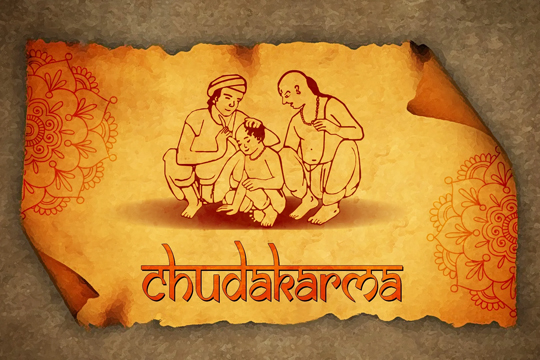
Chowla – chooda karma
‘Chudal’ means a tuft of hair. The Sahasrar Chakra is on the rear of the head from where a tuft of hair is to be kept. Keeping a tuft of hair there and shaving off all the rest is called ‘Choulkarma’ or ‘Chudakarma’.
In all the rituals including Upanayana, the tuft of hair is important. his Sanskar is performed in order to attain longevity, strength and radiance. The small tuft of hair facilitates the entry of Sattva waves from the universe through the Brahmarandhra and functions like the antenna of a television set.
The objective of performing Choulkarma is that once the energy of spiritual intellect is activated in the region of the tuft, it should remain there forever (in other words, our Vivek [Prudence] should always remain in an awakened state).

Naamakarana / Naming ceremony
The naming ritual solemnises the child as an individual, marking the process by which a child is accepted and socialized by people around them. It holds key importance in a child's life. The Baby's deeds, behaviour, and life get influenced by their name. Hence it is a very auspicious event after a child's birth that officially welcomes the child into the family. a happy ritual, in which the family comes together to celebrate the birth of a child now that the tensions of childbirth have passed. Namkaran is also called 'Palanarohan' in some traditions, which refers to putting a child into the cradle (Sanskrit 'palana' = cradle; 'arohan' = onboard).
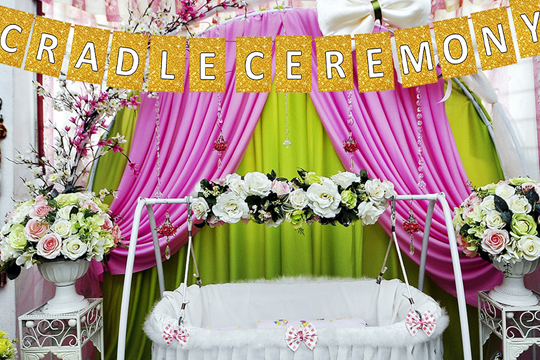
Cradle ceremony / tottilu shatra
A cradle, or thottil, ceremony is performed usually on the 10th, 11th, 12th or 16th day of the baby's birth to signify the baby's independence from his or her mother. In this ceremony, a black spot is put on the baby's forehead to ward off evil.
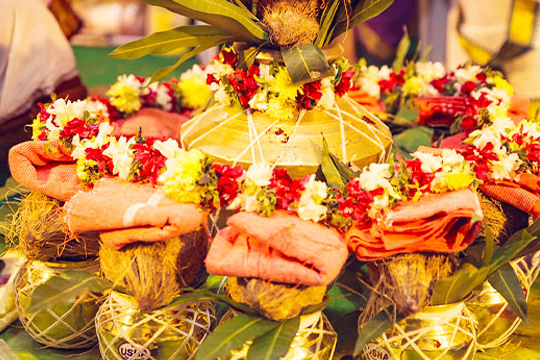
Shasti porta shanti / Ugra Ratha shanti – 60th year shanti
The Ugra Ratha Shanti Homam is the ritual that is celebrated at the beginning of the 60th year of a person when he enters into his 60th year and completes his 59th year of life. The male who completed the 59th year has been given an abhisheka of holy water to commemorate his last year of Vedic cycles and his all-bad sins or karma energies have been resolved.
The Hindu and Vedic ritual Ugra Ratha Shanthi Homam is performed on the day of completion of the 59th birthday and the start of the 60th year of a male. The Ugra Ratha Shanthi Homam is conducted for the good health, wealth, and prosperity of the native. Before the male’s Sashtiaptha poorthi and shasthi poorti, Ugra Ratha Shanthi Homam is conducted.
When a human completes 60 years of his life, it is considered to be perilous for them. As because completing this age is considered hazardous because this period causes ill health in a person’s life. The purpose of performing this Ugra Ratha Shanthi Homam beforehand to initiate the smooth journey of one’s into the sixties.
The Ugra Ratha Shanthi Homam gives the couple health, and strength to their mind and body as it is performed on the day of completing their 59th birthday to appease the god to remove the bad sins and harsh times ahead.
- Ganapati Homam
- Ayushya Homam
- Navagraha Homam
- Mrutyunjaya Homam
- Tithi-Vaara-nakshatra-yoga-karana-samvatsava-ayana Homam
- Sapta Chiranjeevi Homam
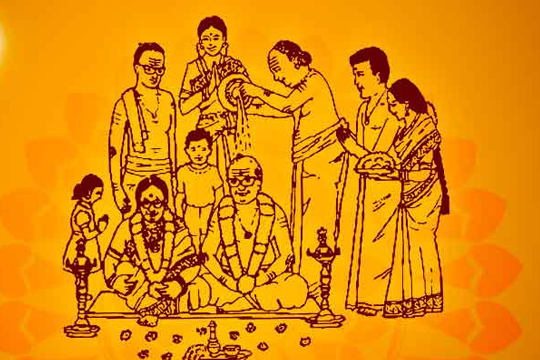
Bheema Ratha Shanti – 70 years
When the male couple enters their 70th year, Bhima Ratha Shanthi 70th Birthday Pooja has performed by the family members and they celebrate it by getting together and performing the Homams, Kalasa abhisheka followed by the exchange of garlands for the couple to get the blessings of the Lord. This ceremony improves the life longevity of the couple and gives them strength and good health. This gives the couple a boost in their spiritual progress, washing away their past sins and bad karmas. On this day all the relatives and friends of the couple gather at a function hall or at a temple or even at their home and witness the ceremony. Bhima Ratha Shanti (70th Birthday) is the marriage ceremony performed for the couple where the husband has completed 70 years of age and the 71st year has started. It is usually organized by the couple’s children or in-laws or relatives.

Sahasra Chandra Darshana shanti -80 years
Sahasra Purna Chandrodaya (or Sahasra Chandra Darshan) is a special occasion to celebrate the 1000th full moon in one's life. This is a Hindu custom in India. The time between phases of a similar moon, or lunar month, averages 29.53 days, so 1000 months equals 29530 days = 80.849 years = approximately 80 years and 10 months.
Family members will conduct shanti pooja for the person who complete 1000 full moon period.
Sahasra Chandra Darshana shanti will give good Health & Mrityunjay Homam, sapta Chiranjeevi Homam removes all mrutyu-kantak and person will live long.
